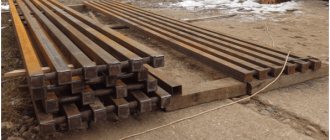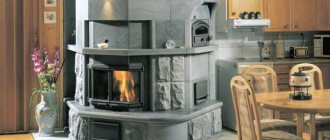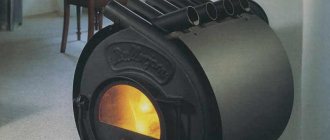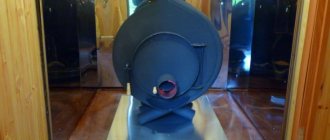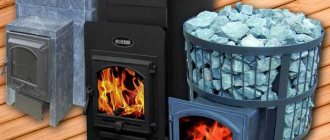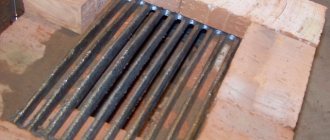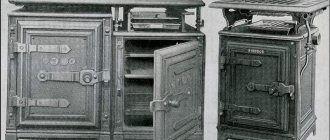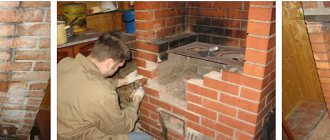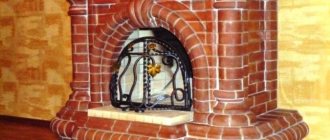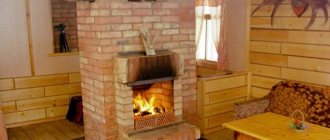Author: Yuriy Fedorovich Kolesnikov, thermal power engineer
A stove is a must for a summer house. Not only and not so much for romance. Not everyone goes to the dacha to have fun; many work on their plot from dawn to dusk and from the first warm spell to the cold. And many people use their dacha as a commercial enterprise, providing them with their main source of income. Freezing at the same time, walking around dirty and chewing dry meat is ruining your own health. Finally, evening gatherings by the fire, like nothing else, relieve fatigue and give a charge of vigor for tomorrow.
Don't forget about fuel. Delivering it outside the city (and there is no need to explain the state of the usual dacha infrastructure) will cost a pretty penny. Hence the main type of fuel is firewood collected on site. But a wood-burning stove for a summer cottage must accept and “digest” other types of waste solid fuel: small brushwood, agricultural waste (kuray), coal, briquettes, pellets from emergency reserves in case of prolonged bad weather; preferably household waste as well.
Based primarily on these conditions, we will try to develop technical, economic and ergonomic requirements for a country stove:
- At the dacha you need a fireplace stove, or a separate stove and fireplace in the room. An evening at the dacha without contemplating a light is not an evening, after a day of work or a hectic spree.
- The country stove must withstand long breaks in the firebox when damp. There is no need to explain why.
- After work, or after a sudden torrential downpour of rain pours directly onto a relaxed group, you need to dry and warm up as quickly as possible, or even pneumonia is not far away. Therefore, the country stove should be heated as quickly as possible and enter the mode of maximum heat transfer by radiation.
- For overnight stays at the dacha in cold weather, it is important that the stove retains heat for a long time, or is heated from evening to morning without flooding.
- Only a heating stove is not suitable for a dacha; you need a hob, because... There may simply not be enough space to arrange both separately in a small house.
- Due to the same circumstance, the country stove should be as compact as possible.
- There is never an abundance of waste fuel, and it is expensive to bring a large fuel supply to the dacha, so the stove must be economical.
- A stove for a summer cottage must allow the integration of a DHW heat exchange register for a shower into it.
- In the summer it’s already hot in a country house, but even a small fireplace will make you steamed. Therefore, it is very desirable that the stove for the dacha is also portable, for cooking outside in the summer.
- No one can sit for long in a wooden house that has dried out in gunpowder during gardening or a picnic, so the country stove must be fireproof and not produce fumes in case of accidental violations of the firebox.
- Finally, calling a stove maker and paying him for his labor on the road is a very expensive pleasure. This also applies to builders when it comes to the foundation for a stove, especially since country houses are often built spontaneously and can simply fall apart due to excavation and concrete work inside them. Therefore, the stove should be so simple that it could be built by a home craftsman with basic qualifications, or so cheap that it would not be a burden on the budget of the average family.
But now, keeping in mind the already established requirements, we will determine which of the popular types of stoves are most suitable for a dacha. As for the appearance and decoration - at your discretion, according to your taste and wallet. Let us just remember A. N. Tupolev’s remark about the aircraft design of one of his colleagues: “It’s an ugly car, it won’t fly well.” And so it turned out. Any beauty will fall on a technically developed design as if it were native, no matter what idealistic aesthetes say.
Materials
Cast iron
In terms of thermal technical and economic indicators, at first glance, cast iron seems to be the best material for a country stove. But, firstly, cast iron stoves are poorly transportable, they are heavy and fragile. Secondly, although they are not afraid of long breaks in the firebox, they warm up for quite a long time when kindling (except for potbelly stoves, which will be discussed later), and it is difficult to build a water heater into them: cast iron is practically impossible to process at home. Finally, cast iron is much more expensive than its welded counterparts. The same advantage of cast iron stoves as absolute durability is not essential for a summer residence. In general, the full benefits of “cast iron” are revealed with regular heating in a permanently inhabited house (garage, workshop, barracks, barnyard), but for a dacha it is better to look for something else.
Brick
Brick stoves have a high heat capacity and, when extinguished, retain heat for a long time: you can sleep without getting up to heat it and without fear of fumes. But a brick oven definitely needs a foundation; it must be built on site and there is no way to take it outside. Finally, brick stoves require regular firing by a fairly experienced stoker, they are afraid of dampness, and after long breaks in use they require “overclocking” - several firings with gradually increasing amounts of fuel. Therefore, you should only think about a brick country stove if the country house is inhabited for at least 6 months a year.
Note: many stove makers, and simply residents of houses with stove heating, are of the opinion that a real, healthy stove should only be made of brick. This is probably just a tribute to tradition - there is no reliable evidence of the usefulness of brick stoves and the harmfulness of other stoves.
Metal
A welded metal stove, unless we are talking about aesthetics and decoration, will be the best option for a dacha . Such stoves are quite light, compact, cheap, mobile, and allow you to easily set up a hob, oven, hot water circuit, air convector for quickly heating the room, etc. True, they are not so durable, especially with regular heating. But for a dacha, this is just a plus: oxides and other chemical compounds of metal, formed under the influence of a flame, interact with air during breaks between fireboxes, forming a durable, heat-resistant deposit. The durability of a metal stove with irregular use is twice or more higher (15-45 years versus 6-8) than with constant firing.
However, long-burning metal stoves (bubafonya, slobozhanka, etc.) cannot be recommended for summer cottages. They are more suitable for production and utility rooms, provided they are serviced by sufficiently qualified personnel. Causes:
- They take too long to “heat up”. While it's really warm, after gardening in the spring or fall, you'll catch a cold. Or you'll fall asleep, taking a sip to warm yourself up, and wake up in the morning.
- It is impossible to arrange a full-fledged cooking surface, unless you boil a kettle or heat up ready-made food.
- They take up a lot of space, because... You cannot move them close to the wall.
- A long-burning stove that has caught fire must under no circumstances be extinguished; it must itself burn down to ash. What if you need to leave the dacha? Sit and wait a day for it to go out, or risk finding firebrands instead of a house on your next visit.
- They are absolutely not romantic: you can’t see the fire, you can’t have a barbecue, you can’t cook shish kebab.
For the same reasons, homemade pyrolysis furnaces are not suitable for dachas, say, for mining. In addition, in inexperienced hands they are not only a fire hazard, but also a risk of explosion. The master who made it must heat it himself with full knowledge of the matter. Factory-made pyrolysis furnaces and boilers are completely safe, have a lot of advantages, but are very expensive.
Constructive decisions
Fireplace stoves are made, in most cases, from steel and cast iron.
Steel - have impressive weight and thick walls. They heat up quickly and cool down just as quickly, designed for small spaces - dachas, country houses.
Cast iron - not much larger in weight, but they take longer to warm up, can heat large rooms, and are more expensive. Cast iron stoves and fireplaces are chosen mainly for home use.
Facing - ceramics, stone, less often - brick. They will quickly heat the room. A sufficiently large viewing glass will allow you to admire the play of fire.
Doors can be straight, semicircular or three-sided. The opening mechanism can also vary - to the side or up. To ensure that the door glass always remains transparent, fireplace stoves have a clean glass option - an air flow is supplied to the glass from the inside, forming an air cushion that prevents soot from settling on the glass. Firewood is also inserted into the combustion chamber through the door. The efficiency of closed fireplace stoves is quite high - 80-90%.
Some models have a built-in heat exchanger in their design. With its help, you can heat adjacent rooms by installing radiators, even if there is a blank partition. It is especially worth noting designs with a water circuit - this is a good solution for permanent residences.
Beauty, comfort, warm home. What else can stoves and fireplaces give you? Delicious dinner. Like a traditional Russian oven, you can cook and heat food in them and even cook shish kebab over an open fire. It’s up to you, of course, to choose a stove or a fireplace, or two in one.
Fireplace power
To choose the ideal unit for your garden or home, you first need to decide on the power. It will not be difficult to calculate this: based on calculations of 1 kW of energy per 10 sq.m. with a ceiling height of 2.5-2.7 meters.
For example, if the house area is 350 sq.m., you will need a fireplace stove producing 35 kW. It is also worth taking into account the number of window and door openings, rooms - heat in the room constantly circulates as it heats up and cools down. Do not forget about the climatic characteristics of the region in which the building is located. Based on all these parameters, we calculate with a reserve and add another 15-30% to the estimated power (depending on the listed factors).
The most popular wood-burning fireplace stoves are models that have a secondary combustion system, which will dramatically reduce wood consumption. Ceramic cladding allows you to warm up the room even after the fire has died down. Glass also gives off heat. Dark cladding is less of a mark. The manufacturer has a line of stoves made of cast iron.
If all the calculations have been made and you have decided on the type of heating device, let’s consider the most popular models in this segment.
About purchased fireplaces
The generally accepted idea that a dacha without a fireplace is not a dacha is completely justified in any case. Already the separation of dreamy-contemplative functions from purely utilitarian ones makes it possible to greatly simplify the choice or construction of a stove. In this case, you need to think about a ready-made fireplace insert, of which the sea is now on sale. Such fireboxes are not very expensive; they run on either biofuel or any flammable waste. They are completely safe, to the point that they can be lined with dry firewood for decoration, or combined with a bookcase or bar. Design - for every taste, see fig. No permission is required.
Country fireplaces
Brick kilns
Let's start looking at country stoves the old fashioned way, with brick ones. Whatever you say, a brick oven adds a special charm to both the dacha itself and outdoor recreation. All brick stoves, if the country house has several rooms, are of good quality: built into the wall, they can heat 2-4 rooms at a time.
Note: the last remark is only valid if the stove is included in the design of a new house. If a stove is being built in an existing house, its foundation should not have a mechanical connection with the foundation of the building, and the body of the stove should not have a mechanical connection with its walls. The reason is unequal shrinkage.
Russian
Russian stove
The Russian stove (see figure on the right) is a phenomenon of global significance not only in the stove business. Experts with academic degrees are still struggling with some of its secrets. And sleeping on a bed (and not just sleeping) when the frost is cracking outside the wall or pouring rain is lashing is an indescribable pleasure. And the gastronomic wonders of Russian cuisine are impossible without a Russian oven.
However, for an ordinary dacha, a Russian stove, despite all the sympathy for it, still cannot be recommended . It is bulky, complex, very expensive, does not tolerate downtime in the cold season, and shows all its advantages only with regular heating. And according to the technical requirements, it takes a very long time to heat, and can only heat one room. In the summer you can’t melt it in the room at all - you’ll bake it yourself; our ancestors built separate stoves outside for the summer. In general, a unique, but not at all country stove. Perhaps for a shady archaic who is ready to go to any expense for the sake of his, primordial, age-old.
Dutch
Dutch ovens
The Dutch oven belongs to the type of channel ovens, and therefore requires a qualified firebox: the viewer was closed at the wrong time, or the oven cooled down in vain, or fumes started. It may be suitable for a dacha due to its compactness: a purely heating unit can be made in the form of a column with a side of 2 bricks, i.e. 520x520 mm, on the left in Fig. With some extension, it allows you to build in a hob (on the right in the figure), but there is a problem with the water heater - like most channel stoves, the Dutch oven does not tolerate disruption of the internal heat circulation.
Another disadvantage for a dacha is that the fuel needs to be of sufficient quality; kurai and garden waste will burn in a Dutch oven, but they will produce a meager amount of heat and a lot of soot, and cleaning the Dutch oven, like all channel stoves, is difficult. Finally, like any brick oven, the Dutch oven takes a long time to warm up, so it is not suitable for quick heating after working in the cold. Of course, it also needs a foundation.
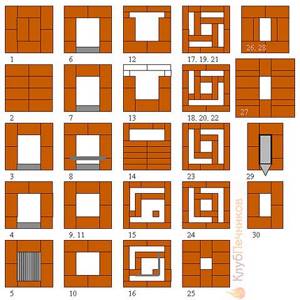
Arranging a compact Dutch oven
The undoubted advantages of the Dutch oven are its simplicity and relative, compared to other brick kilns, low cost. A Dutch oven can be built by a homemaker who has no experience as a stove maker, and no expensive refractories are required; ordinary red brick with clay mortar is sufficient. In Fig. on the left is the order of the Dutch column shown above, and on the next. rice. – Dutch oven with side stove and oven. A Dutch oven can heat up to 4 rooms at once.
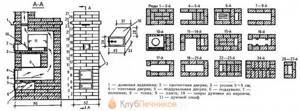
Arrangement of a Dutch heating and cooking stove
Swede
The Swedish oven appeared in the second half of the 18th century, when science was already quite developed and the rational way of human thinking triumphed. Therefore, its efficiency is significantly higher than that of the Dutch (up to 65% versus 40-45%). The Swede was originally a channel-type heating and cooking stove, although later bell-type stoves appeared (see below), operating like a Swede.
The Swede has 3 design features: an oven next to the firebox, an obligatory hob in a niche, and above it there is a voluminous stove (actually, another niche) for drying. From the open door of the oven, immediately after lighting, heat radiates, which allows those who are chilled to quickly warm up. And in the same oven, you can build in a hot water heater for hot water without deteriorating the oven’s performance; The storage tank can be installed at the top of the furnace.
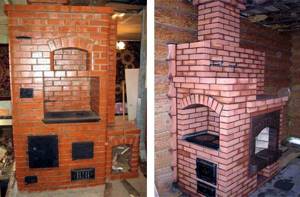
Classic Swedish ovens
The disadvantages of a Swedish stove for a summer residence are common to all brick stoves: it is quite bulky (on the left in the figure), a foundation is required, it must be heated skillfully, like a Dutch stove, and it is just as demanding on fuel. It is difficult to build a Swedish stove, so we do not provide instructions for beginners (especially since they can be found in a separate material about Swedish stoves), but good stove makers know them themselves. In country Swedes, for the sake of compactness, the oven is often turned 90 degrees, and the entire oven is turned the same 90 degrees in the opposite direction. If the dacha is inhabited only in the not very cold season in our area, where the air is generally drier than in Scandinavia, the oven of such a Swede is often turned into a fireplace (on the right in the figure), lined with fireproofing and making an exit into the chimney (then you need additional view), or by bringing the fireplace chimney up parallel to the stove, then you can immediately admire the fire and cook. You can heat 2-3 rooms at once with a Swedish stove.
About bell furnaces
Bell-type furnaces have a much higher efficiency than channel furnaces, they warm up faster, and they can accommodate so-called. gas view, which simplifies the use of the stove and makes it safe. But bell-type stoves are not suitable for dachas: their rather delicate design does not at all tolerate stopping the firebox during the cold season. If a Russian stove that has overwintered in an abandoned hut can still be revived with a special acceleration mode, then the bell-type stove after such a winter will crack from the slightest light in the firebox.
More about fireplaces
A fireplace in a country house is also good because it allows you to quickly warm up, which is required mostly more often than cooking. Based on this, an original design was born: not a fireplace stove, but a country fireplace stove, see fig. below. To light a fire in the fireplace, the damper is opened, the stove burners are closed with standard plugs, and the fire is lit directly on the stove. If used infrequently, this will not ruin it. For cooking, the damper is closed, the fire is lit in the firebox, and the flue gases escape into the chimney through a constantly open bypass channel. In fireplace mode, it ensures good afterburning and increased efficiency.
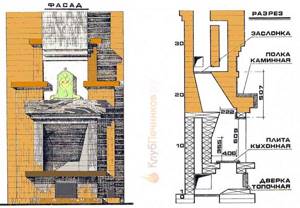
Fireplace stove
About brick barbecues
Barbecue made from construction waste
The category of brick ovens also includes barbecues with stationary grills. Their device is a subject for a separate discussion. Let us mention here that it is for such simple devices that invention, ingenuity and artistic taste are of particular importance. For an example, see Fig. barbecue made from construction waste. And it looks no worse than an expensive designer’s creation made from wild stone.
Why a wood stove?
If we exclude gas and electricity, the first - due to the complexity of installing a separate pipeline, the second - as an expensive energy source for heating, there are not many types of fuel left for a country stove. Coal has a high heat capacity and produces long-lasting and persistent heat . But its cost in regions that are far from coal mining areas negates its advantages. Wood pellets and briquetted fuel have now become popular. The calorific value of these materials is higher than that of firewood, but they are also more difficult to obtain and the price is higher.
At the same time, firewood is a renewable material that grows in abundance throughout most of Russia. In forested regions it is the cheapest type of fuel . A wood-burning stove is also convenient because, if necessary, it can burn not only quality firewood, but also wood waste - old boards and wood products that are not covered with varnish and paint. Although this is not the main source of fuel, such recycling can still be beneficial.
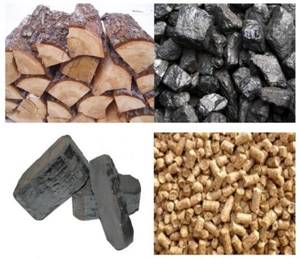
Firewood continues to be the most affordable fuel
Outdoor ovens
An outdoor stove in the country is not a whim, but a necessity. In the summer, when the house is already fried by the Sun, you can’t do without it. The best option here is to buy a ready-made garden barbecue oven, on the left in the figure. below. There are many of these on sale, the production technology is not complicated and well-developed, so purchasing it is unlikely to cost more than any other furnace work. An exception is the purchase of a potbelly stove, about which later. And the garden barbecue oven can be disassembled for the winter and stored indoors. Once completed, two people can move it around the site.
If you have the skills in your hands and the desire to use them more than the extra money in your wallet, then on the right in Fig. Below is a small brick stove for a summer residence in a metal frame. Fireclay brick is not needed for it, ordinary ceramic brick will do, maybe defective, broken, old. The masonry is made with clay mortar without bandaging the seams, so to build this stove, you don’t need to be not only a stove maker, but also a mason.

Outdoor (garden) stoves
This stove is small and remote. When the firebox damper is closed (pay attention to the holes in it!), it goes into the mode of smoldering fuel from the surface, which in warm weather makes it possible to cook using tiny amounts. In spring and autumn, the firebox door can be removed, then the combustion will be fiery and highly active. In general, if you don’t mind building a stove in your dacha yourself, having at the same time delved into the basic intricacies of stove heating technology, then it’s better to start with this one.
Note: the foundation for this furnace is any suitable slab. It may not be solid: the load is small, distributed fairly evenly, and the oven piping will prevent it from cracking when shrinking.
How to make your own stove to heat your home with wood and coal?
What to do if buying a factory model is too expensive? Below are step-by-step instructions for making a stove for wood and coal with your own hands.

Rice. No. 3 Schematic diagram of a homemade boiler
The schematic diagram of such a boiler can be seen in Fig. No. 3 . For manufacturing, heat-resistant steel with a high content of alloying elements is used. Sometimes gas cylinders made of St3 steel with a high carbon content are used.
You can also burn a brick oven with coal. But there are difficulties with constant cleaning. Coal produces a lot of soot.
And the firebox must be made of fireclay bricks. The masonry process itself is also quite labor-intensive and expensive. However, there is a simple option that is quite suitable for a small country house (up to 36 m2).
Setting up a coal and wood stove
Photo:

Rice. No. 4 Detailed order of a brick oven on coal and wood
Laying instructions
For the future, you can download the order.
Step-by-step diagram for making a brick oven using wood and coal:
- To install the furnace, you will need a concrete foundation with reinforcement. The dimensions of the foundation should be 100 mm larger than the dimensions of the furnace. And the height is 500 – 700 mm. The top of the foundation is at -0.150.
- Lay out the base - the first 2 rows (see Fig. No. 4) with standard dressing of vertical seams. The masonry is carried out using cement-sand mortar. Next, fireclay clay is used as a mineral binder.
- The first row is the bottom of the ash pan. The laying is carried out strictly according to the scheme.
- When laying rows 2 and 3, you must remember to position and secure the blower door with wire.
- The fourth row covers the ash pan and the hole for the blower.
- The grate is laid in the 5th row.
- The firebox door is installed when laying 6-8 rows.
- Carry out the laying according to the diagram. Rows 6–9 form the firebox.
- Row 8 is the arch of the firebox. It is made of ¾ brick. And rows 9-14 overlap it.
- Smoke channels are laid out according to the diagram.
- The valves are located in rows 26 and 29.
- Finish covering the furnace.
- Next, lay out the chimney.
- Drying the oven.
Even a beginner can make such a stove with his own hands. It is enough to have basic masonry skills. No complicated tool is required either. Heat-resistant mortar mixtures for laying stoves can be easily purchased at any construction supermarket.
About corner stoves
It is believed that a corner stove saves space. This is true for purchased stoves (on the left in the figure), which are based on a ready-made firebox made of modern materials, see above. As for brick corner stoves erected in existing buildings, the already mentioned “foundation rule” comes to the fore: it must be at least 250 mm away from the foundation of the house.

Corner ovens
If we take into account that the extension of the stove base beyond the contours of its body in plan should be at least 50 mm, then saving space turns out to be illusory. But in return, up to 2 square meters appears. m of living space, not suitable for anything more than collecting garbage. However, on the trail. rice. We present the order of two compact corner stoves: on the left is a heating and cooking stove, and on the right is a fireplace stove.
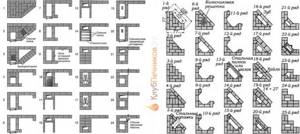
Orders of corner stoves
Design and principle of operation of a wood-burning stove

The modern type of wood-burning heaters consists of a chamber for storing fuel, cast-iron grates, an ash pan for collecting wood residues, and a chimney for removing residual gases. The lumber is placed in the fuel compartment and set on fire. The combustion reaction promotes the formation of gases with high temperatures. They, moving through the pipe, heat the walls of the device, which release heat into the room. The heating rate depends on the housing material.
To support the fire in the combustion chamber, a blower flap and a smoke valve are used. They are opened to a larger or smaller size. When excess air enters, the heat transfer of the structure decreases, and soot quickly appears in the chimney.
A standard stove will heat a house or cottage in an average of 5 hours.
Gas ovens
A gas stove is suitable not only for a gasified dacha. If the dacha is used only in the warm season (say, where the basis of the economy is a garden or apiary), then the stove is needed only for cooking, and searching for solid fuel in the surrounding area or its delivery is no longer justified. The second option, when a gas stove turns out to be better, is to visit the dacha in winter, but only occasionally. Let's say, relaxing after a ski trip or ice fishing.

Gas stoves for summer cottages
For cooking for one person in places completely remote from the benefits of civilization, the optimal choice would be a Taganok stove, pp. 1-3 in Fig. Pos. 1 is a tourist/hunting mini, its refueling lasts for one or two days. For longer-term use (say, for a nomadic apiary), you need to take a Taganok with a cylinder of increased capacity (item 2), it lasts for a week or a month. Recently, an innovation has appeared on sale: a taganok with a reflective burner, pos. 3. Thermal radiation reflector on the cooking utensil allows you to save 15-20% of gas.
For regular picnics, it’s a good idea to get a universal gas barbecue grill, pos. 4. These, as a rule, are equipped with a branded cylinder of sufficiently large capacity, so it can be used to power both an ordinary compact gas stove (item 5) and a portable gas stove with oven, carried in the trunk of a car, item. 6.
A special article on gas heating and cooking appliances is furnaces and calorifiers for catalytic combustion of gas. They are quite expensive, but extremely economical. Their only drawback, which still prevents their widespread distribution, is the small limits of power adjustment, so kitchen models (item 7) are rarely found in everyday life, and instantaneous heaters, directional and non-directional (items 8-10), have to be selected accordingly required heating conditions.
Gas heating appliances for a country house
Gas heater Bartolini Pullover
Gas is one of the most economical and convenient types of fuel. To store it, it is enough to buy a cylinder, while for firewood you need to build a special structure and maintain certain climatic conditions. In addition, the gas does not produce smoke or soot and does not burn oxygen. An exhaust hood is also required for its installation. The only downside is the risk of gas leakage, so you need to work with the stove carefully.
The widespread model can be used as a primary and secondary educational device. Heating is carried out through a catalytic fiberglass panel.
The design of the furnace has a power regulator, piezo ignition, and sensors. They provide high operational safety. It is characterized by high reliability and quiet operation.
The heater on wheels is mobile due to its ease of movement and minimal dimensions. Liquefied gas is used for operation, and heating occurs through an infrared panel. There is rollover protection. It also contains sensors that ensure safety. The cylinder holds 12 liters and is placed inside the housing. During operation of the furnace equipment, ventilation of the room is required.
The stove for the dacha is hung on the wall and includes a heat exchanger made of cast iron. It has a long service life - about 50 years. The convection oven is serviced by sensors and other automation elements that do not depend on electricity. The power supply is only needed to operate the fan.
Both a gas cylinder and mains fuel are suitable for operation. Among the disadvantages, users note the need to create a hole in the wall to supply a gas hose. The advantages include high quality of work, stability, reliability and fast heating time.
Wood stove with water tank
All of the listed types of stoves have their positive and negative features. Each has its own properties and operating conditions. To correctly choose the best model, you need to answer several questions:
- how much space is there to install the stove;
- frequency and time of use of the heater, at what time it is used most actively;
- in what climatic conditions the device will operate;
- what type of fuel is preferable to use;
- is a hob or water tank required?
- where the chimney will be installed.
In addition, it is important to take into account the financial component. It includes the cost of the stove itself, additional components and work on installing and configuring the heater. Funds will be spent on maintaining the stove during the entire period of operation, as well as on fuel.
After this, you can buy a stove or develop a drawing in case of self-assembly.
If your priority qualities are quick heating of the air in the room, long burning for up to 8 hours and the ability to flexibly select equipment, look at the line of Termofor Fire-battery stoves. The younger model for 100 m³ costs from 13 thousand rubles. All models in the line are compact in size and relatively light in weight.
Do you need a cast iron fireplace stove that will become not only a source of heat, but also a stylish piece of furniture? Pay attention to Polish products from Kratki. The Koza K line includes models of different sizes and performance. The most popular modification is Kratki Koza K9 for heating up to 250 m³ at a price of 61 thousand rubles.
Are you looking for an original solution for your home? Be sure to evaluate the capabilities of the Thorma Andorra Exclusive rotating model at a price of 77 thousand rubles. This steel product can be rotated 90 degrees in both directions! At the same time, it is compact due to its cylindrical shape, and the large-area curved glass installed in the door allows you to admire the flames from anywhere in the room.
| Strengthening the foundation of a private house Are you preparing to build an extension to your house? Have you decided to add a second floor? Perhaps the old foundation of the house scares you with an abundance of cracks and uncharacteristic distortion? All this indicates the need to strengthen the foundation. We have tried to summarize data that will be useful in resolving this issue. |
| Drawings of barbecues made of brick and metal The manufacture of any structure, even something as simple as a barbecue, should be carried out taking into account the available drawings. You can take ready-made diagrams, or you can capture your own thoughts on paper. As part of our article, we present several drawings of simple brick and metal barbecues. If you wish, you can always modify them and create a unique product. |
| Construction of a bathhouse from timber A summer cottage without a bathhouse is the same as a popular low-alcohol drink without its 40% counterpart. If you want as few problems with construction as possible, then you should consider using timber. On our part, we guarantee to provide all the necessary information on the technology. |
Ideal: potbelly stove
According to all requirements, except aesthetics and prestige, a potbelly stove is an ideal country stove. First of all, a potbelly stove is not at all as gluttonous as is commonly believed. With proper design and operation, it shows an efficiency of over 50%, and with a special chimney - up to 80%, which is comparable to immeasurably more expensive pyrolysis boilers, but the potbelly stove does not require power supply for pressurization and automation.
Potbelly stove - mobile fireplace
The second is a potbelly stove, due to the elementary simplicity of its manufacture and undemanding nature of materials; the stove is inexpensive, even cast from cast iron. And the cast iron stove is the only one that can withstand many years in pet rooms, where the air is filled with ammonia vapors and other volatile waste products. By the way, this is why army potbelly stoves are cast iron. There is such a ghost in the barracks...
Third, the potbelly stove is truly omnivorous. The only type of fuel for which it lags far behind other stoves in terms of thermal parameters is natural gas. But a potbelly stove can work with waste or dark heating oil; you just need to make a special burner and stick its nozzle into the vent. If the oil burns out, you can put the gas generator in the shed until the next portion of fuel accumulates, and heat it as before.
There are types of potbelly stoves that can be converted into long-burning stoves, for example. Loginov stove. I removed the grate, installed an air choke on the ash pan, put pellets or sawdust in the firebox - it slowly warms up all night without worries or hassle. And in the morning, if the filling has not burned out, you can fill it with water without fear of poisoning by pyrolysis gases, remove the choke, put back the grate, and cook breakfast on it.
Note: this trick will not work with other long-burning stoves - it is dangerous for life!
The next point is that the same potbelly stove can be used, depending on the season, both indoors and outdoors. A welded metal stove with 20 kW of thermal power can be carried 50 m without breaking by one person. Have you seen something similar somewhere? A potbelly stove combined with a factory fireplace insert creates a mobile fireplace (see picture above right) that can be placed anywhere in the house or outside.
Further, a potbelly stove provides almost instantaneous local heating by thermal radiation, even faster than a Swedish oven. In addition to a cast iron stove, a hot water heat exchanger and a hob can be built into a potbelly stove without any difficulty. Finally, installing a potbelly stove in a dacha does not require anything at all: neither a foundation, nor permissions from any authorities, nor a pipe over the roof. Bought it or made it, brought it, installed it - and enjoy it. The chimney can be brought out of the window; this will only make the stove work better. And then it will be easy to supplement the purchased potbelly stove yourself with various useful devices.

Some of the factory stoves
The potbelly stove, of course, has a simple look even in its artistic design, and the chimney in the room does not fit into every interior design. However, thanks to their other outstanding qualities, potbelly stoves are produced by industry all over the world in a huge assortment (see the figure above for some samples) and choosing the right one based on price, purpose and additional functions is not difficult. Just like making a potbelly stove yourself, with basic metalworking skills.
Do-it-yourself iron country stove - step-by-step instructions
The simplest version of an iron stove is the well-known potbelly stove , which is absolutely undemanding in terms of fuel. Improved factory versions can be made of steel and cast iron, have decorative trim and a glass door, and be installed on bent legs. But for self-production, something else is important: simplicity, reliability, straight lines of the design.
Table 2. Characteristics of popular Butakov iron stoves.
| Model | High school student | Student | Engineer | Assistant professor | Professor |
| Room volume, cubic meters m | 100 | 150 | 250 | 500 | 1000 |
| power, kWt | 6 | 9 | 15 | 25 | 40 |
| Dimensions, cm | 37*66*78 | 37*66*78 | 44*76*89 | 57*97*115 | 67*111*125 |
| Weight, kg | 55 | 77 | 113 | 182 | 235 |
| Chimney diameter, mm | 120 | 120 | 120 | 150 | 200 |
| Min. height of the chimney from the grate, m | 5 | 5 | 5 | 6 | 8 |
A good option for self-production is the Loginov . It is distinguished from a conventional stove by the presence of two shelves at the top of the firebox, which more than double the path of burnt gases, increase efficiency and heat output.
Step 1. Cutting the material . Having drawn a diagram of the potbelly stove on paper, estimate all the dimensions. The best option: 80 * 45 * 45 cm. In addition to the box itself, inside you will need to place a grate and two reflective shelves. It is better to make all elements removable. The cutting can be done with a grinder, and the chamfer can be removed from the edges with a grinding wheel.
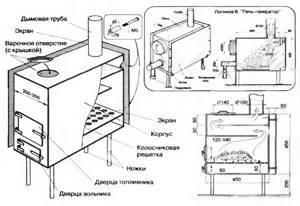
Drawing of Loginov's potbelly stove
Step 2. First, the side and rear walls are welded together , pointwise. They are tapped with a hammer for leveling, placed on the bottom, which is also welded, now along the entire seam to make the parallelepiped rigid. The grate can be made from a sheet of steel with a thickness of at least 4 mm , in which longitudinal holes can be cut. 4 pieces of reinforcement are welded along the inner walls, on which the grate will rest. The upper reflectors are installed in the same way, but always with an offset - the lower one is closer to the front wall, the upper one is closer to the rear.
Prices for popular models of welding machines
Welders
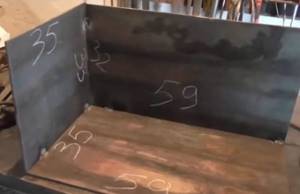
The side and back walls are grabbed first
Step 3. To hang the door, the hinges are first welded onto it, and then onto the front wall. The firebox door is larger than the vent. The easiest way to make latches is from bolt-mounted strips that will fit behind hooks welded to the front wall. The front wall is welded last, after the top sheet with a hole for the chimney.
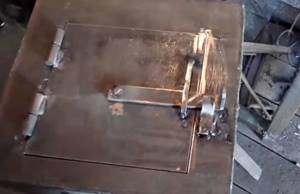
Door version
Step 4. The box is ready . For convenience, legs from pieces of metal corner are welded from below. A section of pipe is welded to the chimney opening, onto which the rest of the pipe is then placed. In this section you need to make a gate, that is, a damper, by adjusting which you can turn an ordinary potbelly stove into a long-burning stove. The principle is simple: if you shut off the damper and close the doors of the firebox and the blower, the air will flow very slowly, and the wood will smolder rather than burn.
By laying a lot of wood, you can stretch one firebox for 8 – 10 hours – just enough to sleep comfortably. Two coaxial holes are drilled in the pipe, a pin is inserted into the bottom, and the outer end is bent 90 degrees . Inside the pipe section, an iron round slightly smaller than the diameter of the pipe is welded to the stud. By turning the pin around its axis, you can adjust the width of the open chimney channel.

The gate allows for slow combustion
Step 5. The height of the vertical pipe is about 1.2 - 1.5 meters . Next comes an inclined part from one and a half to two meters . It is called a hog and also participates in heating the room, because hot gases heat it up greatly. It is better to take it outside through the wall, covering the exit with glass wool or mineral wool.

Well-organized chimney
Place the finished potbelly stove on a steel sheet. Sometimes a screen is hung on the sides. It performs a dual role: protects against contact with hot walls; heating itself, it serves as a plane that releases a lot of heat into the room. With these simple measures you can turn a simple iron stove into a work of engineering art.
Our separate detailed article on the topic - Mixture for laying a brick stove, where we analyzed in detail the correct proportions, as well as tips for mixing it yourself, will be very useful.
About waste ovens
Disposal or destruction of waste in modern holiday villages is a serious problem. The scavengers don’t want to go there any more than the “government” of Ukraine wants to discuss issues of federalization of this great power: if you tell the summer residents how much the export tariff will cost, then, you see, they’ll beat you up. It is prohibited by law to throw garbage in a heap along the road, and it is also harmful and disgusting to yourself. Therefore, home-made people do not ignore waste ovens.
Garbage oven from a barrel
Fuel barrels are most often used as waste ovens, either by cutting a vent at the bottom (see figure), or simply by placing the leaky one on bricks. And indeed, why make holes in a container that is still suitable for its intended purpose?
The garbage in such “heating devices” burns properly, but here’s the problem: you can run into a considerable fine. Especially at a time when firefighters, SES and other regulatory authorities are literally wringing their hands: come on, fill the budget!
Well, for those who want to follow the established rules at all costs, in Fig. Below is a drawing of a waste incinerator, the exhaust of which complies with Russian environmental standards. True, it will have to be documented by the same firefighters and SES. But it’s better to drive thoughts about such matters in the evening at the dacha by the fire.
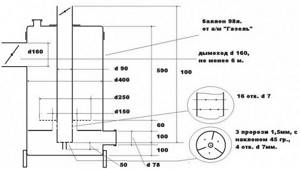
Incinerator drawing
And here again... the potbelly stove comes to the rescue! Any flammable garbage will burn in it, as long as it is not completely wet. What about fines? And here another useful quality of a potbelly stove is revealed. Although the same thing burns in it, and the same thing flies out of the chimney, the formal essence of the process is completely different. Namely: not unauthorized unauthorized disposal of agricultural waste, but provision of vital functions for the inhabitants of the house - heating and nutrition. The fact is that garden waste is not included in the list of prohibited fuels; it does not contain highly toxic or other very harmful substances. Household - yes, it is strictly forbidden to burn it yourself, but dry weeds - please! Why then are they fined for a barrel? And from it there is a pure release of greenhouse gases without any life support. These are the kinds of incidents that happen in the law. And there are even worse ones.
How to choose the right fireplace stove
A large number of craftsmen advise installing cast iron stoves: steel fireplaces are in many ways inferior to this option. A cast iron firebox is smaller in size, but releases heat 3 times longer with the same amount of fuel, which means higher efficiency and less wood consumption.
Marseille 10
A solution from Meta, for those who are located far from central heating and gas mains. It takes longer to melt than steel ones, but at the same time gives off a lot of heat for 7 hours. Uses fuel economically. It has a convection system, and “clean glass” prevents the accumulation of soot and soot. Will fit into any interior.
Marseille 10
| Location | Wall-mounted |
| Power | 10 kW |
| Chimney | 150 mm |
| Door material | Glass |
| Lining | Chamotte |
| Dimensions, mm | 977x513x415 |
| Weight, kg | 103 |
The package includes an ash box. Designed for a room with an area of 80-90 sq.m. The downside is the lack of a heat exchanger and burner. Price from 59,900 rub.
Kratki Koza/K6
An economy-class stove for a summer house and a country house from a Polish manufacturer. Heat regulation occurs through a lever that supplies air to the firebox. Two combustion modes: active provides high fuel efficiency, passive - convenient to use at night. Heat-resistant glass can withstand up to 800°C.
Kratki Koza/K6
| Location | Wall-mounted |
| Power | 9 kW |
| Chimney | 150 mm |
| Chimney connection | Top and back |
| Door material | Glass |
| Lining | Chamotte |
| Dimensions, mm | 668x578x490 |
| Weight, kg | 118 |
The efficiency relative to the size of the furnace is high - 76%. The optimal area of the heated room is 80-90 sq.m. Firewood and/or fuel briquettes are used as fuel. Among the disadvantages, users in the reviews note the lack of a secondary gas afterburning function and the absence of a cooking zone. Price 54,000 rub.

Components and parts are made in France. The design features of the stove include a long-burning system. The connection to the chimney is on top of the fireplace. With the “secondary combustion” and “clean fire” system.
| Location | Wall-mounted |
| Power | 12 kW |
| Chimney | 150 mm |
| Chimney connection | Top and back |
| Door material | Glass |
| Lining | Chamotte |
| Dimensions, mm | 1200x562x460 |
| Weight, kg | 131 |
With such dimensions, it can cope with 200 square meters of heated area. The only downside is that the manufacturer recommends using firewood. It is not clear what the restrictions on fuel briquettes are related to. Price 71150 rub.
Catalytic combustion and the original air convection system increase the productive work time from one fuel ignition by 12 hours. Glass coated with zinc oxide gives off twice as much heat as fireproof glass. The ash drawer can be pulled out even when the stove is running. Thermometer is built-in. There is a cooking area. Firewood can be loaded from the front through a glass door and from the side through a cast iron door.
| Location | Wall |
| Power | 16.1 kW |
| Chimney | 200 mm |
| Chimney connection | Rear side |
| Door material | Glass |
| Lining | Chamotte |
| Dimensions, mm | 840x717x467 |
| Weight, kg | 288 |
The efficiency of the unit is just over 74%. You can use firewood and briquettes as fuel. The minimum heating area is 120 sq.m., the maximum is 220 sq.m. Feature - an adapter is required for connection to a chimney with a round cross-section.
Vesuvius PC-01 (220)
Vesuvius PC-01 (220)
MISTRAL V12
MISTRAL V12
Brandeburg
Brandeburg
MBS Corner
MBS Corner
It is worth noting the mobility and ease of installation of such structures. They do not require a specially constructed foundation, since their weight varies from 100 to 300 kg. If you are planning a redevelopment, the location can be easily changed. They have high heat transfer. It is worth noting that a fireplace stove with a water circuit is not popular among dacha residents, since it is advisable to always be at home to operate it.
Before choosing a fireplace stove, you should pay attention to:
- material of manufacture and its thickness (cast iron, steel);
- area of the heated room;
- firewood consumption;
- additional functions (burners, water heating, connection of radiators);
- price;
- connection method;
- installation location.
Pros of choosing a hybrid:
- ideal for cottages and country houses;
- warms up the room from scratch in an hour;
- economical consumption of firewood;
- ignition in the shortest possible time;
- long burning.
The disadvantages are mainly associated with improper commissioning and neglect of safety precautions:
- fire hazard - do not install near flammable surfaces;
- if there is a burner, the likelihood of getting burned increases;
- It is necessary to make a high-quality smoke exhaust system to prevent emergency situations.
Russian stove
Dutch
Dutch oven
